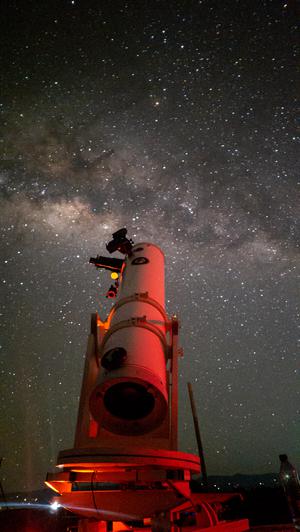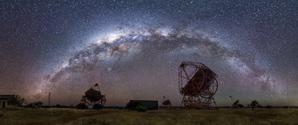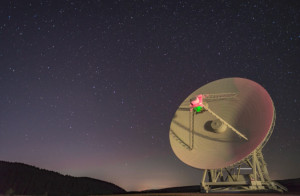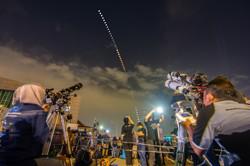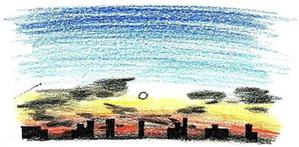Glossary term: Observation
Description: Astronomical observations involve collecting and/or measuring electromagnetic radiation, particles, or gravitational waves reaching us from an astronomical object. In the past, humans observed with their eyes, and from the early 1600s through telescopes. Now a variety of cameras, spectrometers, and other instruments can also be used. The information that is collected, such as a raw image we retrieve from a camera, is known as (observational) data.
This data contains information about the object and the intervening medium (e.g. the interstellar or intergalactic medium), but still depends on the specifics of the instrument, for instance if one part of the camera is more sensitive than another. The data also depends on contaminants; for example, when collecting light from an astronomical object, we will typically also collect foreground light scattered in Earth's atmosphere. Removing instrument-specific and contaminant portions as completely as possible is called data reduction. Typical end products of observations are images, spectra, and time series (repeated observations of the same object or objects, for instance, data from pulsars or variable stars). These can be used to measure various quantities such as the angle between two objects, the time an event was observed, or the apparent magnitude of an object.
Observations differ from the experiments carried out in many scientific laboratories in that the observer cannot interact with the astronomical objects themselves in the same way as a chemist mixing two chemicals can. In some contexts, observations can sometimes be supplemented by experiments on the objects themselves such as the study of meteorites or by sending space probes to objects in the Solar System.
Related Terms:
- Apparent Magnitude
- Electromagnetic Radiation
- Observatory
- Particle
- Spectrum
- Gravitational Waves
- Variable Star
See this term in other languages
Term and definition status: This term and its definition have been approved by a research astronomer and a teacher
The OAE Multilingual Glossary is a project of the IAU Office of Astronomy for Education (OAE) in collaboration with the IAU Office of Astronomy Outreach (OAO). The terms and definitions were chosen, written and reviewed by a collective effort from the OAE, the OAE Centers and Nodes, the OAE National Astronomy Education Coordinators (NAECs) and other volunteers. You can find a full list of credits here. All glossary terms and their definitions are released under a Creative Commons CC BY-4.0 license and should be credited to "IAU OAE".
If you notice a factual error in this glossary definition then please get in touch.
Related Media
Learning Nights
Credit: Juan Pablo Botero Londoño/IAU OAE (CC BY 4.0)
License: CC-BY-4.0 Creative Commons Attribution 4.0 International (CC BY 4.0) icons
Milky Way Over H.E.S.S Observatory
Credit: Jianfeng Dai/IAU OAE (CC BY 4.0)
License: CC-BY-4.0 Creative Commons Attribution 4.0 International (CC BY 4.0) icons
Southern Sky Over La Silla
Credit: José Rodrigues/IAU OAE (CC BY 4.0)
License: CC-BY-4.0 Creative Commons Attribution 4.0 International (CC BY 4.0) icons
The Big Dipper with the Sardinia Radio Telescope SRT
Credit: Antonio Finazzi/IAU OAE (CC BY 4.0)
License: CC-BY-4.0 Creative Commons Attribution 4.0 International (CC BY 4.0) icons
The Eclipse Between Us, by Muhammad Rayhan, Indonesia
Credit: Muhammad Rayhan/IAU OAE
License: CC-BY-4.0 Creative Commons Attribution 4.0 International (CC BY 4.0) icons
Related Activities
Build a Safe Sun Viewer
astroEDU educational activity (links to astroEDU website) Description: Build a safe Sun viewer using cheap household items and learn why it is dangerous to look directly at the Sun, even briefly.
License: CC-BY-4.0 Creative Commons Attribution 4.0 International (CC BY 4.0) icons
Tags:
Hands-on
, Safety
Age Ranges:
6-8
, 8-10
, 10-12
Education Level:
Primary
, Secondary
Areas of Learning:
Modelling
, Observation based
Costs:
Low Cost
Group Size:
Group
Skills:
Planning and carrying out investigations
Street Lights as Standard Candles
astroEDU educational activity (links to astroEDU website) Description: Understand astronomical distances using street lights
License: CC-BY-4.0 Creative Commons Attribution 4.0 International (CC BY 4.0) icons
Tags:
Hands-on
, Distances
, Distance measurements
, Inverse square law
Age Ranges:
14-16
, 16-19
, 19+
Education Level:
Informal
, Secondary
, University
Areas of Learning:
Modelling
, Structured-inquiry learning
, Technology-based
Costs:
Low Cost
Duration:
3 hours
Group Size:
Group
Skills:
Analysing and interpreting data
, Constructing explanations
, Developing and using models
, Planning and carrying out investigations
, Using mathematics and computational thinking
Evening Sky Watching for Students
astroEDU educational activity (links to astroEDU website) Description: Let's observe the evening sky with the naked eye
License: CC-BY-4.0 Creative Commons Attribution 4.0 International (CC BY 4.0) icons
Tags:
Art
, Observation of sky
, Sky watching
, Motion of star
Age Ranges:
4-6
, 6-8
Education Level:
Pre-school
, Primary
Areas of Learning:
Discussion Groups
, Observation based
, Social Research
Costs:
Free
Duration:
30 mins
Group Size:
Group
Skills:
Asking questions
, Communicating information
